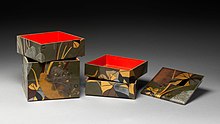
Jūbako ( 重箱, lit. "tiered boxes") are tiered boxes used to hold and present food in Japan. [1] The boxes are often used to hold osechi, foods traditional to the Japanese New Year, [2] or to hold takeaway lunches, or bento.
A sagejū (提重, lit. "portable jūbako") or sagejūbako (提げ重箱), is a picnic set of jūbako in a carrier with handle. [3]
There is also jikirō (食籠, lit. "food basket"), a kind of chinese styled bowl, [4] some stackable like jūbako. [5]
Gallery
-
An 18th century wood, gold and silver foil jūbako
-
Sagejū
-
Jikirō
See also
- Tiffin carrier: tiered lunchbox of India and the Caribbean
References
- ^ "Food and Dishware as Landscapes". Highlighting Japan. Public Relations Office of the Government of Japan. 2021-01-02. Archived from the original on 2021-01-20. Retrieved 2021-08-11.
- ^ "Osechi-ryori: The New Year's Feast". Consulate General of Japan in New York. 2020-11-26 [2016]. Archived from the original on 2017-07-14. Retrieved 2021-08-11.
- ^ "Portable Picnic Set (sagejū) with Chrysanthemums, Foliage Scroll, and Tokugawa Family Crest 18th century". Metropolitan Museum of Art.
- ^ "The Lacquer Artisan Sano Chokan". Kyoto National Museum. Archived from the original on 2018-08-24. Retrieved 2021-08-11.
- ^ Lawrence, Trevor (1895). Huish, Marcus B. (ed.). Catalogue of the collection of Japanese works of art : formed between the years 1869 and 1894. (privetely printed). p89: item 1186; p82: item 1186. hdl: 2027/yale.39002044802859.


